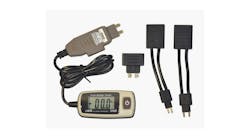Many technicians might not be familiar with a Megohm, aka Megger meter, but it’s not all that different from your Digital Multimeter’s (DMM) ohm meter. So before we move on to using the Megger, let’s take a look at what the DMM’s ohm and diode function actually do.
Here we’re testing the cable and making sure it’s not shorted to the shielding. Meter reading is 2.2 Gigohms.
Have you ever wondered what the difference is between the Ohm and Diode functions of the meter? We all know that the Diode function of the meter is used to check a diode, but what’s the difference? When we connect our leads properly to the diode, we should see a reading on the meter. When we reverse the meter leads on the diode, we should not get a reading if the diode is good. If the meter provides reading on both sides, the diode is shorted and if there is no reading on both ends the diode is open. Now with that out of the way let’s see the difference from the Ohm, Diode and the Megger meter functions. What’s the difference? Voltage. Each of the functions on a meter will supply a different voltage.
A typical DMM will apply about 2.5 to 3.0 volts to a component when performing a normal Ohm or resistance test. However, when testing a diode using the Diode test selection, the meter will apply more than 7.0 volts. You would not use the Ohms selection to check a Diode, just like you would not use either the Ohm or Diode selection to properly test a high voltage cable or hybrid motor-generator (MG). Both the Ohm and Diode tests cannot provide enough “pressure” to properly test HV cables or MGs. The Megohm meter can supply 1,000-plus volts; a voltage level necessary to provide enough pressure to uncover a voltage leak in a cable or MG. Now that we have provided a quick overview, we are ready to move on to testing with the Megger.
Here I wanted to simulate a bad (shorted) cable reading. Replace cables that have failed. NEVER try to repair one.
Before we move on, a serious word of caution. Like both the Ohm and Diode test, the Megger meter is a resistance test. And also like any other Ohm test, the circuit being tested must be “off” and disconnected from its power source while being tested. The vehicle being tested must have its high voltage (HV) systems DISCONNECTED before performing any test with the Megger.
Insulation Testing
Knowing how to perform an insulation test is vital in order to detect any HV cable or MG problems. The Megohm test will provide results on whether there is damage to the cables or MGs that are leaking voltage. Think of the insulation test like a water pressure test on a pipe where the pressure is increased to 125 percent of the pipe’s working pressure. While pressure testing a pipe, you would look for water leaks by increasing pressure to a point where you see water shooting out somewhere, right? Well, in testing hybrid vehicle cables, instead of water pressure, there’s electrical pressure, aka voltage, that the Megohm meter supplies.
Two tests need to be made for the MG stator; short to ground and short to each of the three windings. This is a good reading for short to ground.
This is why you would need to use a Megohm meter since it allows the user to select 1,000 volts, which is just a bit under the 125 percent of water pressure we would use in testing a pipe. The working voltage on most hybrid systems is about 500 AC volts. The insulation test uses nearly double of the required high-test voltage to detect leaks for us. When testing a water pipe, we increase the pressure above the working pressure to make sure the system is leak free, the same would be true for the hybrid system. We would select the 1,000 volt test range on the Megohm tester, since that would be about double of the working system voltage as recommended by the OE. Whether or not cables or MGs pass an insulation test tells us whether there is damage or not. Providing the proper test voltage is important when working on hybrid vehicles in order to confirm that the HV system is leak free. A Prius hybrid Inverter, for example, uses 500 to 650 AC volts to operate the MGs properly. A leakage in the cables would impact MG operation and may even result in an HV leak shutdown.
Here’s an MG stator that is known bad, testing for short to ground and using the stator core as the ground point just like we used to use when testing alternators.
Start any testing of the HV systems by first powering down the high voltage components and isolating the HV battery assembly. Keep in mind that many hybrid systems use HV capacitors that need time to bleed off before you can work near them. Follow the procedures outlined by the manufacturer. Verify with a capable high voltage multimeter that there is, indeed, no voltage present on the cable connections. Follow all safety procedures anytime you’re dealing with HV components; wear protective gloves that are current and have been properly inspected, wear leather overlays over those and make sure there is someone near by that knows where the shop’s safety hook is and how to use it, just in case. I don’t know of any tech that has yet died because of high voltage shock, and I don’t want any of you to be the first. And if you have no formal training on HV systems, you need to get that training preferably in a hands-on course with a quality instructor at your side.
Testing HV Cables
Take a look at the following test where the black lead of the meter is on the cable terminal end and the red (special lead that allows the user to press the white button to supply 50 to 1,000 volts) is on the shield and cable. The first test is checking the shield to the cable making sure they are not shorted.
The meter display of 2.2 gigohms/1,000 volts shows us that the shielding and the cable are NOT shorted. The next cable I tested displays a totally different reading. The meter displays 0 ohms of resistance/1,000 volts. This result shows us that the cable is shorted shorted to the shielding. Any reading under specification spells failure for the cable and requires the cable to be replaced.
Testing HV Motor Generator Windings
Way back in the day, we used to do Ohm resistance tests of the windings in a traditional three-phase alternator. Testing the windings in a hybrid motor-generator is pretty much the same thing. We need to check for voltage leaks to ground and between each winding and its partners.
The MG has three windings (three phase) and each pair of windings needs to be tested to see if any of them are shorted to another. This is a bad reading.
You don’t have to take the MG out to perform this test. Just disconnect the cables from the Inverter/Converter after Power Down (shutting down HV voltage) the system. Start by connecting the black Megger meter lead to the MG’s ground. Then, using the red meter lead, check the insulation resistance on each lead. On the Prius MG2 shown in the accompanying photos, the three leads are labeled U, V and W. As with the cable test, a good reading should be near 2.2 gigohms/1,000 volts. Any reading under the specification listed by the manufacturer is a fail.
If the individual windings pass the ground insulation test, move on to the windings themselves. Connect the leads to the meter in pairs. In the case of the MG2, we’ll need to test U-V, V-W and U-W to cover them all. Again, looking for a reading near 2.2 gigohms/1,000 volts to pass the windings.
NOTE: It’s not a good practice to test the cables while they are connected to the Inverter/Converter.
Our Megger is checking one of the two HV battery cables to check if the cable is compromised from the shield to cable or body ground (when tested on the vehicle). If the meter displays the 2.2 gigohms, the wiring is good. Our in-vehicle test from the HV battery pack cables and Inverter (disconnected) are being tested to ground with our black meter lead on ground and the red lead on the cable connector(s), both cables have to be tested. The next test is making sure that the shield to ground is ok and the last test is the cable to shield test to make sure that the cables are in good shape.
Like any resistance test, be sure the tested part is isolated for accurate results.
To perform this test in the vehicle you will to remove the cables from the Inverter and HV battery and then install your Megohm meter to each of the three MG winding cables (the U, V and W) and ground. As seen in the picture connect the black lead to the case and the red lead to one of the cables from the converter and press the white button to see if the reading are good or bad. You need to perform the same test from every cable to the case ground and from each terminal to the others to make sure that the wirings are not shorted to one another.
Scan tool Parameter Identifiers (PIDs) might be available that will display the resistance of the cables. The normal reading is about 400,000 (400K) ohms, as displayed on the Honda Civic Hybrid scan data example shared in this article. Lower readings indicate a cable that is leaking or grounded. Any scan tool data that has a Diagnostic Trouble Code (DTC) with a description of a decrease in resistance or short
Scan tool data can be helpful in identifying insulation resistance issues. Just keep in mind that some PIDs are inferred and not actual measurements.
circuit typically indicates a HV cable or MG problem. The cables might have been compromised by debris or obstructions in the road, or from an accident. I worked on a Honda hybrid that had the HV cable damaged from a piece of metal that was on the road, piercing the exhaust pipe and damaging the HV cable when the driver ran over it, making for one expensive repair. This Honda needed the cables from the back of the vehicle to the MG replaced.
And just in case you are thinking that you can tape or repair a damaged HV cable, remember that these cables carry a lot of punch and are exposed to rain, snow, dirt and salt. There are no acceptable repairs other than replacement of the complete cables.
I hope that you now have a better feel for using a Megohm meter since it’s very similar to an Ohm meter. With a good understanding of how and when to use the Megger and a solid hybrid training background, you’re on your way to completing your first HV diagnosis.
Subscribe to Motor Age and receive articles like this every month…absolutely free. Click here








